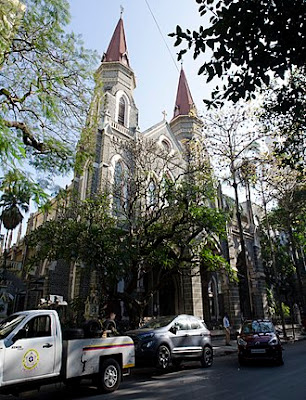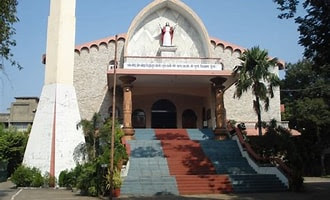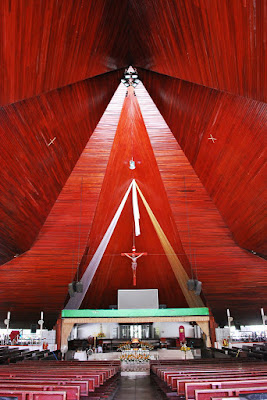India-3
This blog covers seven ecclesiastic provinces in northwest India. See my previous blogs about India.
- 6-1-2020—India 1
- 6-6-2020—India 2
The reader should know that most Indian archdioceses have websites in English that may be of interest.
Province of Bombay (Mumbai)
The province consists of part of the civil State of Maharashtra. The Metropolitan Archdiocese of Bombay began as an apostolic vicariate in 1637 and became a metropolitan archdiocese in 1886.
Holy Name Cathedral in Mumbai was completed in 1905 in a Gothic Revival style. The gray stone church is highly decorated with colorful frescos of yellow and pink geometric designs on a pale green background. The yellow ceilings depict scenes from the life of Christ.
The first picture is from Pinterest, the second from TripAdvisor and the last two from Wikipedia.
The Province has three suffragan dioceses.
- The Diocese of Poona was created as an apostolic vicariate in 1854 and became a diocese in 1886.
- The Diocese of Nashik was created in 1987.
- The Diocese of Vasai was created in 1998.
Province of Agra
The province consists of the civil States of Uttar Pradesh, Rajasthan, and Uttarakhand. The Metropolitan Archdiocese of Agra began as a Mission sui juris in 1784, became the Apostolic Vicariate of Tibet-Hindustan in 1820, and the Metropolitan Archdiocese of Agra in 1886.
The Cathedral of the Immaculate Conception in Agra was built in 1848 and designed by an Italian priest/architect. The floor is paved with white and black marble slabs.
All pictures are from Wikipedia.
The Province has nine suffragan dioceses.
- The Diocese of Allahabad was created in 1886.
- The Diocese of Ajmer was created as a Mission sui juris in 1890, became an apostolic prefecture in 1891 and became a diocese in 1913.
- The Diocese of Lucknow was created in 1940.
- The Diocese of Jhansi was created as an apostolic prefecture in 1940 and became a diocese in 1954.
- The Diocese of Meerut was created in 1956.
- The Diocese of Varanasi was created as an apostolic prefecture in 1946 and became a diocese in 1971.
- The Diocese of Udaipur was created in 1984.
- The Diocese of Bareilly was created in 1989.
- The Diocese of Jaipur was created in 2005.
Province of Delhi
The province consists of the civil States of Punjab, Himachal Pradesh, and Haryana, and the Union Territories of Delhi, Jammu and Kashmir, Ladakh, and Chandigarh. The Metropolitan Archdiocese of Delhi began as the Metropolitan Archdiocese of Simla in 1910, was renamed Delhi and Simla in 1937, and acquired its current name in 1959.
The Cathedral of the Sacred Heart in New Delhi was built in the 1930s. It was designed by a British architect in an Italian style and financed by British colonial officers. The main altar is made entirely of marble and has a fresco of the Last Supper behind it. A facade of white pillars supports the canopy, and on each side of the cathedral's entrance, there are circular arcaded turrets rising above the roof. The interior has a towering curved roof, polished stone floors and broad arches.
The first three pictures are from Wikipedia and the last is from worthycanvas.
The Province has three suffragan dioceses.
- The Diocese of Simla and Chandigarh was created in 1959 as Simla and acquired its current name in 1964.
- The Diocese of Jalandhar was created as an apostolic prefecture in 1952 and became a diocese in 1971.
- The Diocese of Jammu-Srinagar was created as an apostolic prefecture in 1952 and became a diocese in 1986.
Province of Nagpur
The province consists of part of the civil State of Maharashtra. The Metropolitan Archdiocese of Nagpur became a diocese in 1887 and a metropolitan archdiocese in 1953.
St. Francis de Sales Cathedral in Nagpur was built between 1879 and 1886 in a French Gothic style. The bell towers were added in 1897 and 1909. A stained glass window depicting St. Francis de Sales was imported from France in 1935. There is also a replica of Da Vinci’s “The Last Supper.” The ceiling is inspired by churches in Paris. See peterherald.blogspot.com.
The first picture is from a local blog, the second from Panaramio, and the third from Wikipedia.
The Province has three suffragan dioceses.
- The Diocese of Amravati was created in 1955.
- The Diocese of Aurangabad was created in 1977.
Province of Bhopal
The province consists of the civil State of Madhya Pradesh. The Metropolitan Archdiocese of Bhopal was created in 1963.
The Cathedral of St. Francis of Assisi in Bhopal is 150 years old.
Pictures is from a local blog.
The Province has five suffragan dioceses.
- The Diocese of Indore was created as a Mission sui juris in 1931, became an apostolic prefecture in 1935 and a diocese in 1952.
- The Diocese of Jabalpur was created as an apostolic prefecture in 1932 and became a diocese in 1954.
- The Diocese of Khandwa was created in 1977.
- The Diocese of Gwalior was created in 1999.
- The Diocese of Jhabua was created in 2002.
Province of Gandhinagar
The province consists of the civil State of Gujarat and the Union Territory of Dadra and Nagar Haveli. The Metropolitan Archdiocese of Gandhinagar was created in 2002.
Premavatar Isu Mandir (which I think translates as Incarnation) Cathedral in Gandhinagar was built between 1985 and 1990. The parish has about 900 members.
The Province has two suffragan dioceses.
- The Diocese of Ahmedabad was created as a Mission sui juris in 1934 and became a diocese in 1949.
- The Diocese of Baroda was created in 1966.
Province of Raipur
The province consists of the civil State of Chhattisgarh. The Metropolitan Archdiocese of Raipur began as an apostolic prefecture in 1964, became a diocese in 1973, and a metropolitan archdiocese in 2004.
St. Joseph’s Cathedral in Raipur was built in 1984.
Both pictures are from a local blog.
The Province has three suffragan dioceses.
- The Diocese of Raigarh was created in 1951.
- The Diocese of Ambikapur was created in 1977.
- The Diocese of Jashpur was created in 2006.
Definitions
The Catholic Church is mostly divided into ecclesiastical provinces—a province consists of a metropolitan archdiocese and one or more dioceses. The province and the archdiocese are led by an archbishop. Each of the dioceses is called a suffragan diocese and is led by a bishop. Archbishops have some responsibilities for the province, but all bishops answer directly to the Pope. There are also jurisdictions below the level of a diocese. These include missionary jurisdictions including apostolic vicariates, apostolic prefectures, ordinariates, and Missions sui juris.
Most Catholics in the world belong to the Latin or Roman rite. Rite refers to liturgical practices, ecclesiastical discipline, and spiritual heritage. Many Catholics belong to one of two dozen Eastern rite churches. Eastern rite churches trace their heritage to Eastern Europe and the Middle East. Eastern rite churches sometimes use different terminologies. For example, a diocese might be called an eparchy and is led by an eparch. A vicariate apostolic is called an exarchy (or apostolic exarchate) and is led by an exarch.





































